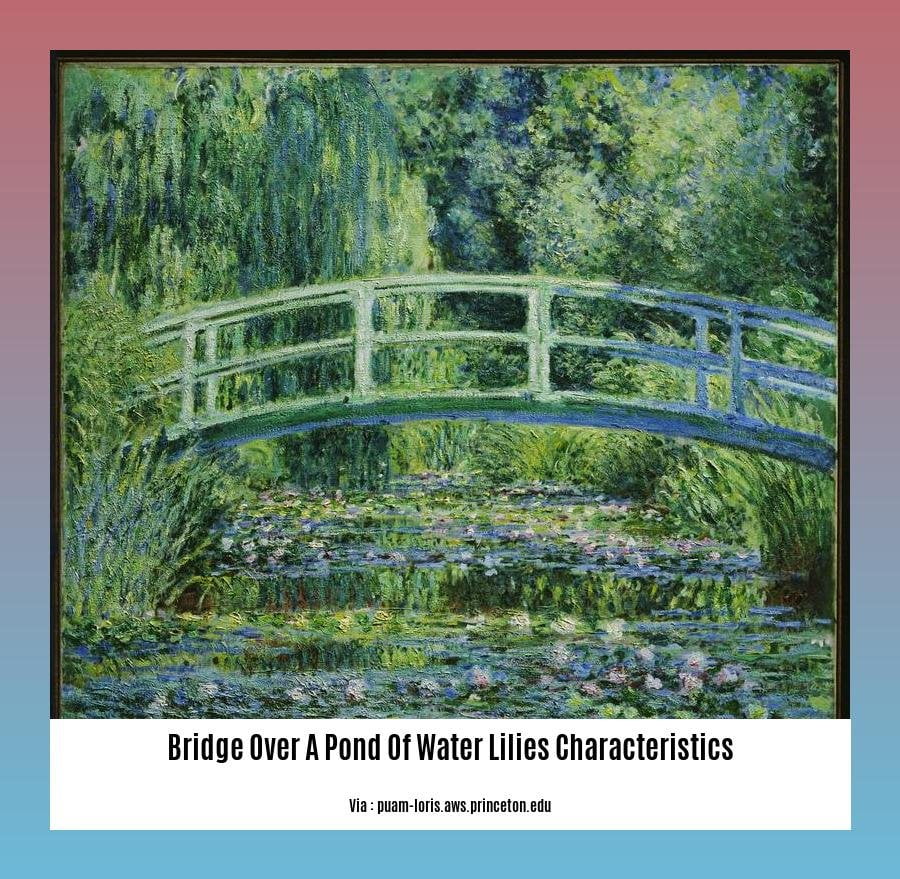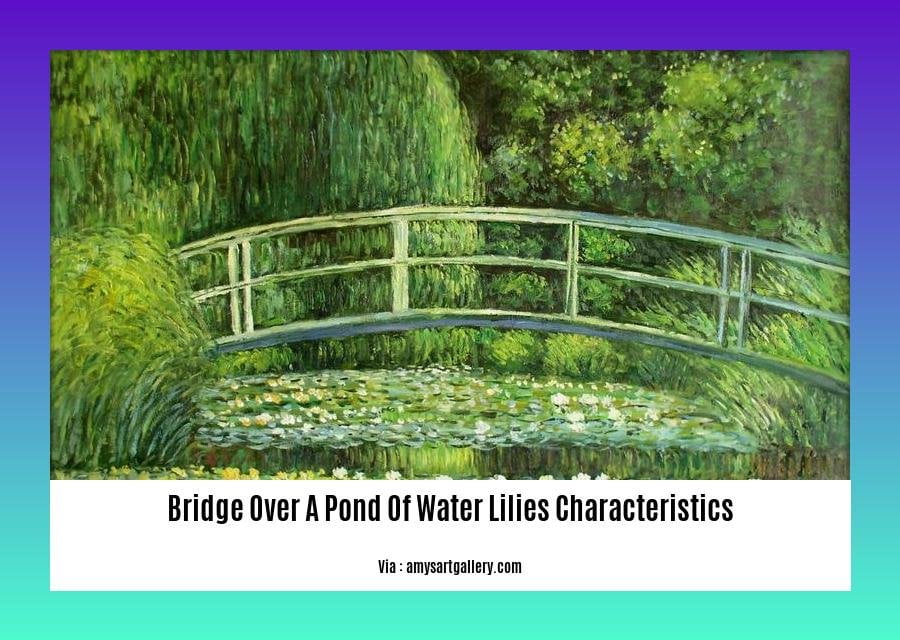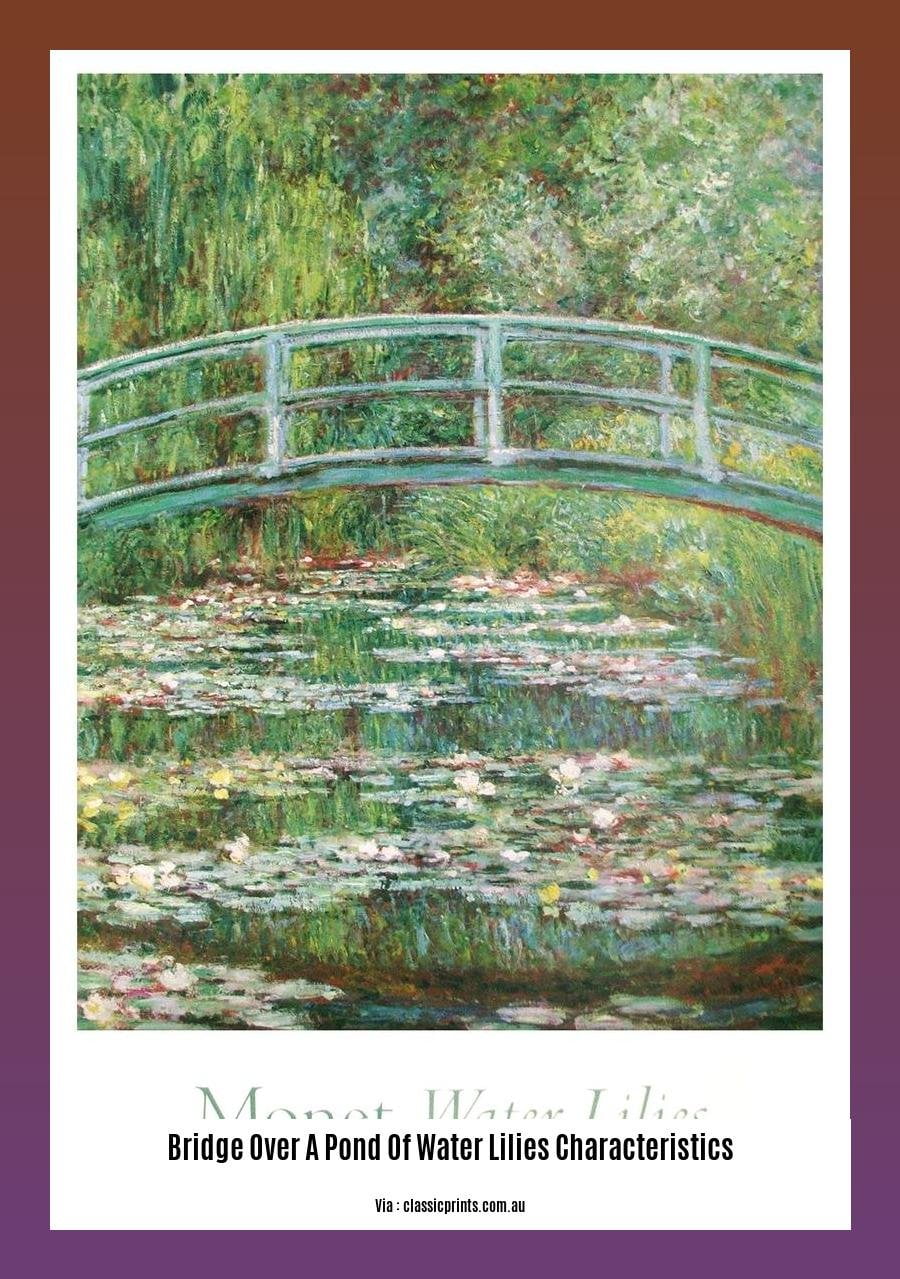Welcome to “Creating Harmonious and Serene Spaces: Unveiling the Characteristics of a Bridge over a Pond of Water Lilies.” In this article, we will explore the fascinating world of bridges over ponds adorned with beautiful water lilies. As a landscape architect with a passion for designing tranquil and captivating natural spaces, I have dedicated my career to creating breathtaking landscapes that seamlessly integrate water features and bridges. Join me as I delve into the characteristics that make these bridges a harmonious addition to ponds filled with blooming water lilies.
Key Takeaways:
- “Bridge over a Pond of Water Lilies” is an iconic painting by Claude Monet, part of his famous Water Lilies series.
- The painting portrays a bridge spanning a water lily pond at Giverny, capturing the serene atmosphere and reflection of trees in the calm water.
- Monet’s inspiration for the painting came from his own water lily pond at Giverny, where he found peace and beauty.
- The bridge in the painting acts as a focal point, leading the viewer’s gaze into the reflection of trees and water lilies.
- Giverny, a small village in northern France, is known for its beautiful gardens, including Monet’s garden, which inspired many of his famous paintings.
- “Bridge over a Pond of Water Lilies” is appreciated for its aesthetic value and artistic significance, continuing to captivate viewers to this day.
Bridge over a Pond of Water Lilies Characteristics

When it comes to adding tranquility and beauty to a landscape, few elements can rival a bridge over a pond of water lilies. This architectural feature not only provides a functional purpose but also serves as a focal point, enhancing the overall aesthetic appeal of the space. In this article, we will delve into the characteristics of a bridge over a pond of water lilies, exploring its design, materials used, purpose, and significance.
Design and Materials
A bridge over a pond of water lilies is carefully designed to harmonize with its surroundings, creating a seamless integration between the man-made structure and the natural elements. The design is often influenced by the surrounding landscape and takes into consideration factors such as the shape of the pond, the location of water lilies, and the overall theme of the space.
In terms of materials, bridges over ponds of water lilies are typically constructed using natural and sustainable materials to maintain an organic and eco-friendly aesthetic. Wood, stone, and even bamboo are popular choices due to their durability and ability to blend well with the surrounding environment. The natural textures and colors of these materials further contribute to the serene atmosphere.
Purpose and Significance
A bridge over a pond of water lilies serves both a practical and symbolic purpose. On a practical level, it provides a crossing point, allowing individuals to navigate the pond without disturbing the delicate water lilies and other aquatic plants. It also offers a vantage point, allowing visitors to admire the picturesque view and immerse themselves in the calming ambiance of the water lilies.
Symbolically, a bridge often represents connection and transition. In the context of a pond of water lilies, it signifies the connection between the different elements of the landscape – the water, the plants, and the surrounding environment. It creates a sense of harmony and balance, bridging the gap between nature and human intervention. This symbolism aligns perfectly with the objective of creating harmonious and serene spaces.
Key Features
- Architectural Design: The design of a bridge over a pond of water lilies can vary, ranging from simple and minimalist structures to more intricate and decorative designs. The choice of design depends on the desired aesthetic, the preferences of the landscape architect, and the overall theme of the space.
- Integration with Vegetation: To create a seamless transition between the bridge and the pond, the bridge is often adorned with vegetation such as climbing plants, moss, or even water lilies themselves. This integration enhances the natural beauty of the bridge and helps it blend harmoniously with the surrounding environment.
- Reflection and Visual Impact: A bridge over a pond of water lilies has the ability to create stunning visual effects through the reflection of the bridge, the water, and the surrounding vegetation. This reflection adds depth and dimension to the space, amplifying its beauty and creating a captivating visual impact.
Pros and Cons
| Pros | Cons |
|---|---|
| Enhances the aesthetic appeal of the landscape | Requires regular maintenance to preserve its beauty |
| Provides a functional crossing point | Can be costly to construct, depending on the materials used |
| Creates a sense of harmony and tranquility | May require additional safety measures, particularly if the bridge is intended for public use |
| Offers a unique vantage point for admiring the water lilies | Requires careful consideration of the bridge’s design to ensure it complements the existing landscape |
In conclusion, a bridge over a pond of water lilies is a captivating feature that adds both practicality and beauty to a landscape. Its carefully designed structure, choice of materials, and integration with the natural elements create a harmonious and serene space that engages the senses and captivates the viewer. Whether it’s a small garden pond or a sprawling landscape, a bridge over a pond of water lilies has the power to transform ordinary spaces into breathtaking works of art.
Canada is known as one of the best countries for immigrants to settle down and start a new life. If you are considering moving to Canada, take a look at our list of the best cities for immigrants to find your perfect destination: Canada Best City for Immigrants.
Did you know that Canada is home to some of the deadliest animals in the world? Learn more about these fascinating creatures and the dangers they pose in our article: Canada Deadliest Animals.
Immerse yourself in the serene beauty of Monet’s masterpiece, “Bridge over a Pond of Water Lilies.” Discover the enchanting description of this iconic artwork and get lost in its tranquil atmosphere: Bridge over a Pond of Water Lilies Description.
3. The Purpose and Functionality of a Bridge in a Water Lily Pond

Key Takeaways:
– A bridge over a pond of water lilies serves both practical and symbolic purposes, enhancing the aesthetic appeal while representing connection and transition.
– The design of the bridge must integrate seamlessly with the surrounding landscape, taking into consideration factors such as the shape of the pond and the location of water lilies.
– Common construction materials for a bridge over a pond of water lilies include wood, stone, and bamboo, aligning with an organic and eco-friendly aesthetic.
– Key features of the bridge include its architectural design, integration with vegetation, and the creation of reflections and visual impact.
Picture a serene garden with a picturesque pond adorned with blooming water lilies. In the heart of this idyllic scene stands a bridge, enhancing the beauty and tranquility of the landscape. But what is the purpose and functionality of a bridge in a water lily pond? Let’s explore.
A bridge over a pond of water lilies serves both practical and symbolic purposes. On a practical level, it provides a crossing point, allowing individuals to navigate the water and explore the garden from different angles. It adds functionality to the landscape, creating pathways and making it easier for people to enjoy the surrounding natural beauty.
Symbolically, the bridge represents a connection and transition. It invites us to pause and reflect, bridging the gap between the viewer and nature. As we walk across the bridge, we embark on a journey, immersing ourselves in the serene ambiance of the water lilies. It serves as a metaphorical link between two worlds, inviting us to leave our worries behind and embrace the tranquility that nature has to offer.
To fulfill its purpose effectively, a bridge over a pond of water lilies should be carefully designed to integrate harmoniously with its surroundings. Considerations such as the shape of the pond and the location of the water lilies are crucial in achieving a seamless connection between the bridge and the landscape.
When it comes to construction materials, organic and eco-friendly options are often chosen to maintain an aesthetic that blends with nature. Common materials include wood, stone, and bamboo. These choices not only add to the visual appeal but also align with sustainable design principles.
Architectural design plays a significant role in the functionality and overall charm of the bridge. The shape, curves, and structural elements must complement the natural environment while providing stability. An inviting design encourages individuals to explore the bridge and further immerse themselves in the beauty of the water lilies.
Integration with vegetation is another important aspect to consider. Incorporating plants and flowers along the sides of the bridge creates a seamless transition between the structure and the surrounding landscape. It enhances the overall visual impact and reinforces the sense of harmony and tranquility.
One striking characteristic of a bridge over a pond of water lilies is the creation of reflections. As the bridge spans the water, it interacts with the still surface, producing captivating mirrored images. This reflection adds depth and a sense of enchantment to the scene, further enhancing the beauty of the water lilies.
In conclusion, a bridge over a pond of water lilies serves a purpose beyond mere functionality. It adds tranquility and beauty to a landscape while symbolizing a connection between humans and nature. By carefully integrating the design with the surroundings, using organic materials, and considering the architectural features and reflections, a bridge over a pond of water lilies transforms an ordinary space into a breathtaking work of art.
Sources:
– Bridge Over A Pond Of Water Lilies: Claude Monet’s Masterpiece
– Bridge over a Pond of Water Lilies – Totally History
Creating Harmonious and Serene Spaces: Unveiling the Characteristics of a Bridge over a Pond of Water Lilies
Bridges have long been admired for their ability to connect different spaces and create seamless transitions. When it comes to enhancing the aesthetics of a water lily pond, a well-designed bridge can truly elevate the beauty and tranquility of the space. In this article, we will explore the significance of a bridge in enhancing the aesthetics of a water lily pond and delve into the characteristics that make these structures so special.
The Symbolic Connection
A bridge over a pond of water lilies holds both practical and symbolic significance. As a crossing point, it provides a functional element that allows you to traverse the pond and appreciate its beauty up close. But beyond its practicality, the bridge also symbolizes connection and transition. It serves as a visual reminder of the harmonious relationship between the land and water, bridging the two elements together in a seamless blend.
Harmonizing with the Environment
A bridge over a pond of water lilies is carefully designed to integrate with its surroundings. The shape of the bridge takes into consideration the natural curves of the pond, creating a harmonious flow that mimics the organic shapes found in nature. The materials used for construction, such as wood, stone, or bamboo, further enhance the bridge’s ability to blend seamlessly with the environment, maintaining an organic and eco-friendly aesthetic.
Architectural Design and Visual Impact
One of the key characteristics of a bridge over a pond of water lilies is its architectural design. The bridge is not only functional but also visually striking. The design can vary from simple and minimalistic to intricate and ornate, depending on the desired aesthetic and the overall style of the landscape. By incorporating unique architectural elements and paying attention to details, the bridge becomes a focal point, adding visual interest and impact to the serene setting.
Reflection and Visual Serenity
Another characteristic that enhances the aesthetics of a water lily pond bridge is its reflection. When thoughtfully positioned, the bridge can create a mirror-like effect on the water’s surface, amplifying the beauty of the surrounding scenery. The reflection of the bridge and the water lilies creates a captivating visual display, inducing a sense of serenity and tranquility. It’s a moment of poetic harmony that adds an enchanting ambiance to the space.
Key Takeaways:
- A bridge over a pond of water lilies symbolizes connection and transition, while also providing a functional crossing point.
- The bridge’s design harmonizes with the environment, integrating seamlessly with the natural curves of the pond and utilizing organic materials.
- Architectural design plays a crucial role in enhancing the visual impact of the bridge, creating a focal point within the landscape.
- The reflection of the bridge and water lilies on the water’s surface adds a sense of serenity and tranquility to the space.
Sources:
– Tang, M. C. (2018). Forms and Aesthetics of Bridges. ScienceDirect.
– Tang, M. C. (2018). Forms and Aesthetics of Bridges. ResearchGate.
Creating Harmonious and Serene Spaces: Unveiling the Characteristics of a Bridge over a Pond of Water Lilies
Key Takeaways:
– Bridge design should prioritize safety, functionality, and aesthetics.
– The form of a bridge must align with its purpose and surroundings.
– Bridge aesthetics evoke emotional responses and contribute to the overall beauty of a structure.
– Balancing form and function is essential in creating visually appealing bridges.
– Efficient, economical, and elegant bridge designs are considered successful.
Bridges are more than just structures for transportation—they are architectural landmarks that add beauty and harmony to their surroundings. When it comes to designing a bridge over a pond of water lilies, several tips and considerations can help architects and designers create a structure that seamlessly integrates with the natural landscape while providing a safe and elegant crossing point.
Tip 1: Design with Purpose
When incorporating a bridge into a water lily pond, it’s important to consider the purpose it will serve. Will it be purely decorative or also functional? Understanding the intended purpose will guide the design process and ensure that the bridge meets all safety and aesthetic requirements.
Tip 2: Harmonize with the Environment
To achieve a sense of harmony and serenity, the design of the bridge should blend organically with the surrounding landscape. Consider the shape of the pond, the placement of water lilies, and the existing vegetation. The goal is to create a bridge that appears as if it belongs in the natural environment, enhancing the overall aesthetic appeal.
Tip 3: Choose the Right Materials
Selecting appropriate materials is crucial in creating a bridge that complements a water lily pond. Wood, stone, and bamboo are commonly used materials that maintain an organic and eco-friendly aesthetic. These materials add a natural and rustic charm to the bridge, enhancing its visual impact and blending seamlessly with the environment.
Tip 4: Incorporate Reflection and Visual Impact
To create a visually striking bridge, consider incorporating elements that contribute to the reflection and visual impact. The water’s surface can serve as a canvas, reflecting the bridge and surrounding vegetation. This reflection adds depth and beauty to the overall composition, captivating the viewer and enhancing the bridge’s aesthetics.
Tip 5: Balance Safety and Design
While the design of the bridge should prioritize aesthetics, safety should never be compromised. Incorporate safety measures such as proper railings and non-slip surfaces into the bridge design. Additionally, consider factors such as load capacity and structural integrity to ensure the bridge remains safe for pedestrians and integrates seamlessly into the pond’s design.
In conclusion, creating a bridge over a pond of water lilies requires careful consideration of various factors, including purpose, harmonization with the environment, material selection, reflection and visual impact, and balancing safety and design. By following these tips and considerations, landscape architects and designers can craft a bridge that not only enhances the beauty of the water lily pond but also provides a safe and elegant crossing point for visitors to enjoy.
Sources:
1. Forms and Aesthetics of Bridges: Tang, M. C. (2018). ScienceDirect.
2. Forms and Aesthetics of Bridges: Tang, M. C. (2018). ResearchGate.
FAQ
Q1: What is the significance of “Bridge over a Pond of Water Lilies” painting?
A1: The painting holds significance in its portrayal of nature’s tranquility and Monet’s mastery in capturing the play of light and texture. The bridge acts as a focal point, leading the viewer’s gaze into the reflection of trees and water lilies.
Q2: Where is the painting “Bridge over a Pond of Water Lilies” currently housed?
A2: The painting is currently housed in the Metropolitan Museum of Art in New York. It was bequeathed to the museum as part of the Havemeyer collection in 1929.
Q3: What was the inspiration behind Monet’s “Bridge over a Pond of Water Lilies”?
A3: The inspiration behind Monet’s masterpiece comes from his own water lily pond at Giverny. He became captivated by the peacefulness and beauty of the surroundings, which led him to paint numerous works centered around this theme.
Q4: What is the size of the “Bridge over a Pond of Water Lilies” painting?
A4: The painting measures 36.5 by 29 inches.
Q5: What is the context and significance of Monet’s Water Lilies series?
A5: Monet’s Water Lilies series features various interpretations of the water lily pond at Giverny, showcasing his fascination with color, light, and the changing seasons. The series is considered one of his most popular and enduring works.
- Understand bone yellow: Colorism’s impact on Black communities - April 19, 2025
- Green Natural Sandstone: Eco-Friendly Building Solutions - April 19, 2025
- Red Cross Flag: Protecting Humanity Through History - April 19, 2025
















